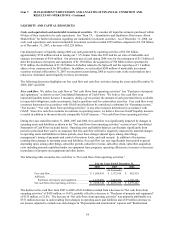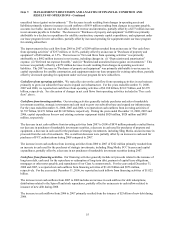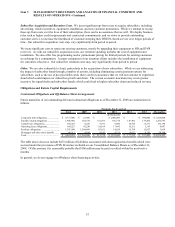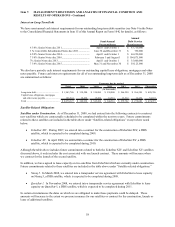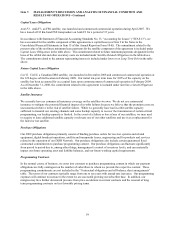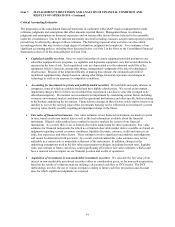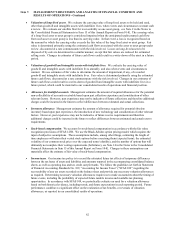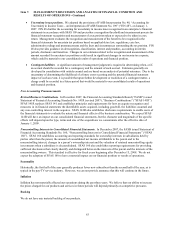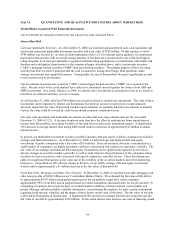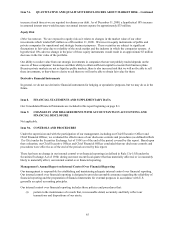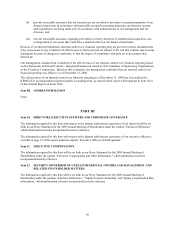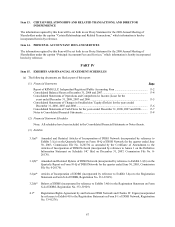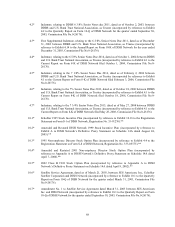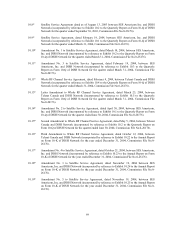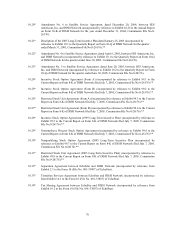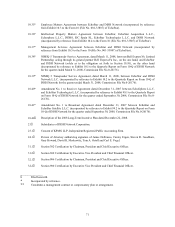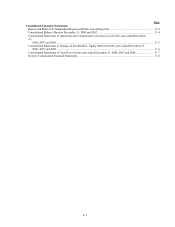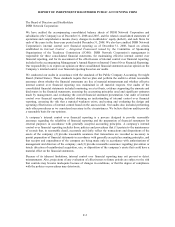Dish Network 2008 Annual Report Download - page 74
Download and view the complete annual report
Please find page 74 of the 2008 Dish Network annual report below. You can navigate through the pages in the report by either clicking on the pages listed below, or by using the keyword search tool below to find specific information within the annual report.64
Item 7A. QUANTITATIVE AND QUALITATIVE DISCLOSURES ABOUT MARKET RISK
Market Risks Associated With Financial Instruments
Our investments are exposed to interest rate and equity price risks, discussed below.
Interest Rate Risk
Cash and Marketable Securities. As of December 31, 2008, our restricted and unrestricted cash, cash equivalents and
current and noncurrent marketable investment securities had a fair value of $756 million. Of that amount, a total of
$740 million was invested in: (a) cash; (b) debt instruments of the U.S. Government and its agencies; (c) commercial
paper and corporate notes with an overall average maturity of less than one year and rated in one of the four highest
rating categories by at least two nationally recognized statistical rating organizations; (d) instruments with similar risk,
duration and credit quality characteristics to the commercial paper described above; and (e) auction rate securities
(“ARS”), mortgage-backed securities (“MBS”) and asset-backed securities. The primary purpose of these investing
activities has been to preserve principal until the cash is required to, among other things, fund operations, make
strategic investments and expand the business. Consequently, the size of this portfolio fluctuates significantly as cash
is received and used in our business.
Our investments in auction rate securities (“ARS”) and mortgage backed securities (“MBS”) are reported at fair
value. Recent events in the credit markets have reduced or eliminated current liquidity for certain of our ARS and
MBS investments. As a result, effective in 2008, we classify these investments as noncurrent assets as we intend to
hold these investments until they recover or mature.
As of December 31, 2008, all of the $740 million was invested in fixed or variable rate instruments. The value of these
investments can be impacted by interest rate fluctuations, but while an increase in interest rates would ordinarily
adversely impact the fair value of fixed and variable rate investments, we normally hold these investments to maturity.
Further, the value could be lowered by credit losses should economic conditions worsen.
Our cash, cash equivalents and marketable investment securities had an average annual return for the year ended
December 31, 2008 of 3.2%. A decrease in interest rates does have the effect of reducing our future annual interest
income from this portfolio, since funds would be re-invested at lower rates as the instruments mature. A hypothetical
10% decrease in average interest rates during 2008 would result in a decrease of approximately $5 million in annual
interest income.
In general, our marketable investment securities portfolio includes debt and equity of public companies we hold for
strategic and financial purposes. As of December 31, 2008, we held strategic and financial debt and equity
investments of public companies with a fair value of $14 million. These investments, which are concentrated in a
small number of companies, are highly speculative and have experienced and continue to experience volatility. The
fair value of our strategic and financial debt and equity investments can be significantly impacted by the risk of
adverse changes in securities markets generally, as well as risks related to the performance of the companies whose
securities we have invested in, risks associated with specific industries, and other factors. These investments are
subject to significant fluctuations in fair value due to the volatility of the securities markets and of the underlying
businesses. A hypothetical 10% adverse change in the price of our public strategic debt and equity investments
would result in approximately a $1 million decrease in the fair value of that portfolio.
Fixed Rate Debt, Mortgages and Other Notes Payable. At December 31, 2008, we had fixed-rate debt, mortgages and
other notes payable of $4.821 billion on our Consolidated Balance Sheets. We estimated the fair value of this debt to
be approximately $4.075 billion using quoted market prices for our publicly traded debt, which constitutes
approximately 99% of our debt, and an analysis based on certain assumptions discussed below for our private debt. In
completing our analysis for our private debt, we evaluate market conditions, related securities, various public and
private offerings, and other publicly available information. In performing this analysis, we make various assumptions
regarding credit spreads, volatility, and the impact of these factors on the value of the notes. The fair value of our debt
is affected by fluctuations in interest rates. A hypothetical 10% decrease in assumed interest rates would increase the
fair value of our debt by approximately $193 million. To the extent interest rates increase, our costs of financing would


